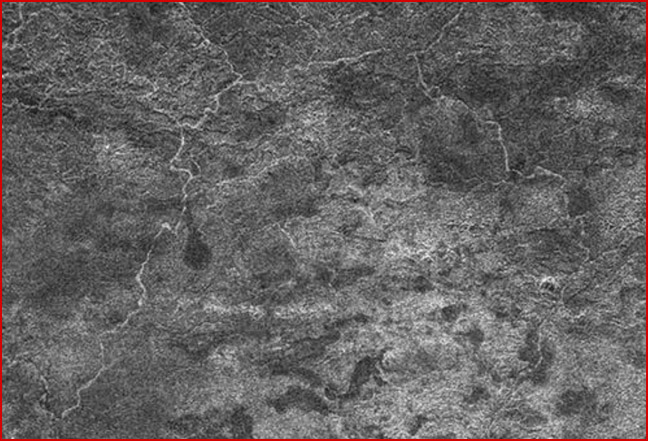
home •
about •
essential guide •
picture of the day •
thunderblogs •
news •
multimedia •
predictions •
products •
get involved •
contact
picture of the day archive subject index
X-Ray image from the Cassini probe to Saturn’s moon Titan captured the above image of Titan’s surface,
including a network of supposed “river channels” located atop the Xanadu region.
Jul 31, 2006
Titan’s Sinuous Rilles
New radar images of Saturn’s moon Titan, taken by the Cassini spacecraft, offer tantalizing clues about the moon’s geologic history.
New images from the Cassini spacecraft offer further tests of predictions made by electrical theorist Wallace Thornhill a little more than a year ago.
The region called Xanadu displays dunes, hills, valleys and mountains as high as the Appalachians. In fact, NASA scientists suggest that the landscape looks a lot like Earth’s surface, though it appears to have been carved largely in ice.
"This land is heavily tortured, convoluted and filled with hills and mountains," said Steve Wall, the Cassini radar team's deputy leader at NASA's Jet Propulsion Laboratory. "Xanadu has been washed clean. What is left underneath looks like very porous water ice, maybe filled with caverns."
But this surface profile is a far cry from what NASA scientists had expected prior to the descent of the Huygens probe and prior to these more recent radar images. What scientists expected to find were seas of methane, and the expectation was based on “simple reasoning.” Great volumes of methane are escaping from Titan’s atmosphere. Accepted theory required that this methane be replaced continuously, or it would have run out millions of years ago. But no surface methane has been located.
NASA scientists are now dealing with a familiar puzzle – one that we have observed again and again in the history of comet investigations. If what theory requires is not seen on the surface, it must be hidden under the surface – and in great abundance! (Cf., the futile search for sufficient surface water on comets to sustain the “dirty snowball” theory.) So the theorists began to envision periodic outbursts of methane from subsurface reservoirs, subsequently raining down in vast floods. But no such rains have been observed, nor has flowing methane been found. Therefore, the scientists reason, these rains must be unpredictably episodic!
Following this reasoning, the scientists even have another observational fact to cite. Across the surface of Xanadu, images reveal long winding channels (see picture above), which the scientists identify as methane “river networks.” The NASA press release states, “At the region's western edge, dark sand dunes give way to land cut by river networks, hills and valleys. These narrow river networks flow onto darker areas, which may be lakes.”
But again, flowing methane has never been found on Titan. Though no one can predict the actual state of things on Titan with certainty, we are confident that neither rains of methane nor rivers of methane nor lakes of methane will be found on Titan’s surface. The entire line of reasoning follows from a precarious assumption. We further predict that if the NASA theorists will look at the topography with sufficient care, they will see that the so-called rivers do not follow terrain in the fashion of flowing liquids – which of course is always downhill.
This expectation is not a wild guess but a cautious prediction based on the observations of sinuous rilles on other planets and moons, including the body Thornhill deemed Titan’s “sister,” the planet Venus. As noted in our Picture of the Day for Feb 03, 2005, on Venus we see Baltis Vallis, a sinuous channel with many counterparts on Venus, this one spanning some 6,800 kilometers. Planetary scientists claim that Baltis Vallis was cut by flowing lava, but the ravine, maintaining a constant width, rises and falls again and again, with some 2 kilometers of elevation separating its high and low points.
.
Evidence from both historical investigation and decades of space exploration suggests that Venus and Titan share a geologically recent birth in an electrically active phase of solar system history. Electrical discharges during that phase would have excavated narrow, sinuous channels as they traveled uphill and downhill without regard for gravity. This defiance of gravity is, in fact, one of the defining features of electric rille formation. And together with electrically carved rilles, Titan’s continuing loss into space of a dense natal atmosphere of methane is an expected consequence of recent birth.
___________________________________________________________________________Please visit our Forum
The Electric Sky and The Electric Universe available now!

|
|

|
EXECUTIVE EDITORS:
David Talbott, Wallace Thornhill
MANAGING EDITORS:
Steve Smith, Mel Acheson
CONTRIBUTING EDITORS: Dwardu Cardona, Ev Cochrane,
C.J. Ransom, Don Scott, Rens van der Sluijs, Ian Tresman
WEBMASTER: Brian Talbott
Copyright 2006: thunderbolts.info
![]()
home •
thunderblogs •
forum •
picture of the day •
resources •
team •
updates •
contact us

